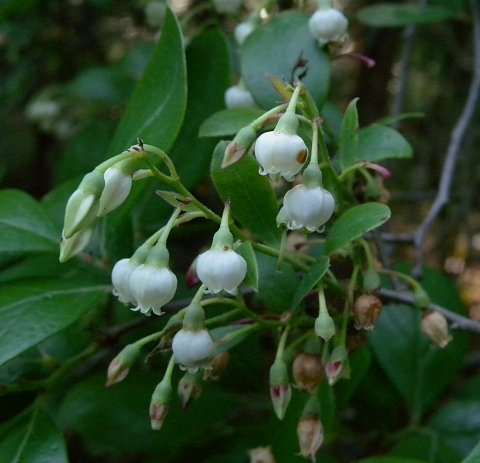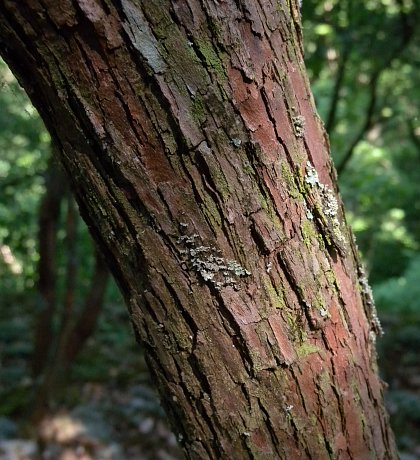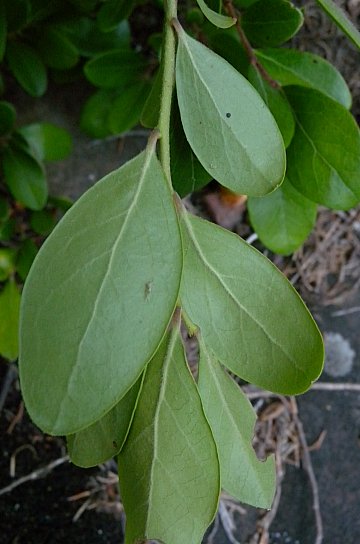
Racemes of nodding flowers up to 2" long are produced near the tips of the twigs of the preceding year. These racemes are produced individually or in small clusters of 2-5. The central stalks of these racemes are light green and finely pubescent, while the pedicels are about ½" long, light green, and glabrous (or nearly so). Each flower is about ¼" long and similarly across, consisting of a short calyx with 5 broad teeth, a bell-shaped corolla that is nearly globoid in shape, 10 inserted stamens, and a pistil with a single style. The calyx is light green and glabrous, while the corolla is usually white (less often pinkish white). The corolla also has 5 small lobes along its outer rim that are recurved. In addition to the flowers, the racemes have leafy to scale-like bracts that are less than 1" in length. The blooming period occurs from late spring to early summer for about 3 weeks.

Afterwards, fertile flowers are replaced by globoid berries that become 6-8 mm. across at maturity during the late summer or fall. Mature berries are black and shiny, often persisting into the winter. The interior of the berries is mealy and dry, varying in flavor from bitter to sweet. Each berry contains up to 10 seeds. The seeds are stony, shiny, and variously shaped; they are about 2 mm. in length. This small tree or shrub reproduces by reseeding itself. In Illinois, Farkleberry is late-deciduous, while in areas further to the south its leaves can be evergreen.
Cultivation: The preference is full or partial sun, dry conditions, and an acidic soil that is rocky or sandy. Farkleberry may not be winter-hardy in areas north of its native range. Flowers are usually abundant, but production of fruit is highly variable from year-to-year. Because of its attractive leaves, flowers, and fruit, Farkleberry would be an attractive landscape plant, but it transplants with difficulty.

Range & Habitat: The native Farkleberry is occasional in southern Illinois, while in the rest of the state it is absent (see Distribution Map). Illinois lies along the northern range limit of this species. Habitats include rocky ledges, upper slopes of rocky canyons, upper slopes of rocky ravines, the tops of cliffs, rocky bluffs, sandstone glades, barren upland savannas, and upland rocky woodlands. In many of these habitats, Farkleberry is found in association with Juniperus virginiana (Eastern Red Cedar) and Quercus stellata (Post Oak). Outside of Illinois, Farkleberry is also found on sand dunes, sandy savannas, and other sandy areas, often in association with Pinus spp. (pines). Because of its thin bark, Farkleberry is vulnerable to fire.
Faunal Associations: The flowers are cross-pollinated primarily by various bees seeking nectar and pollen. Insects that feed on the foliage, wood, plant juices, and fruit of Farkleberry are probably similar to those that feed on blueberries; more specific information is unavailable. The berries are eaten by various mammals and birds; this includes the Black Bear, Eastern Chipmunk, Bobwhite Quail, and American Robin. White-Tailed Deer occasionally browse on the twigs and foliage.

Photographic Location: Rocky ledges above a sandstone canyon in southern Illinois.
Comments: Farkleberry is the tallest member of the Heath family (Ericaceae) in Illinois. Therefore, it can be distinguished from other Vaccinium spp. within the state by a combination of its size and preference for dry rocky habitats. It is possible, however, to confuse small specimens of Farkleberry with other species in this genus. Generally, the leaves of Farkleberry have secondary veins that are more widely spaced than those of other similar species (a 10x hand lens may be required to make such distinctions). A very rare species in Illinois, Vaccinium stamineum (Deerberry), is a smaller shrub that has flowers with more open corollas and its berries are more edible to humans than those of Farkleberry. Deerberry also favors dry rocky habitats. The reddish wood of Farkleberry has been used to make tool handles and craft items. It is heavy, hard, and strong.